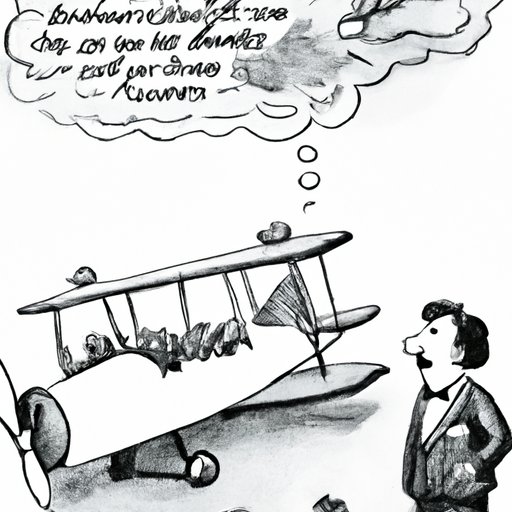Introduction
The invention of the airplane is one of the most remarkable achievements in human history. It has revolutionized transportation, communication, and commerce, enabling people to travel around the world with unprecedented speed and ease. This article will explore the background and technical developments that enabled the invention of the airplane, as well as its impact on society.
Biography of the Inventor
The invention of the airplane is credited to Orville and Wilbur Wright, two brothers from Dayton, Ohio. They were born in 1871 and 1867, respectively, and were raised in a family of seven children. The brothers developed a passion for engineering and mechanics from an early age, and often tinkered with bicycles and kites in their spare time. In 1899, the Wright brothers began to experiment with the idea of powered flight, and soon became convinced that heavier-than-air flight was possible.
In 1903, the Wright brothers achieved the first successful powered flight with their “Flyer” airplane. The four-second flight covered 120 feet and demonstrated that a heavier-than-air craft could be flown under its own power. The Wright brothers continued to refine their designs over the next few years, eventually achieving flights of up to 24 miles in distance and nearly an hour in duration.
History of Aviation
Though the Wright brothers are credited with inventing the airplane, they were not the first to attempt powered flight. For centuries, people have been experimenting with various forms of aerial transportation, including hot air balloons and gliders. However, it wasn’t until the late 19th century that the technology became available to make powered flight a reality.
In 1891, German engineer Otto Lilienthal successfully flew a glider for several hundred meters. His experiments provided valuable data on lift and drag, which would later prove essential for the development of the airplane. Other pioneers, such as Samuel Langley, also made important contributions to the field of aviation.
In the 20th century, advances in engine design and aerodynamics enabled the rapid development of the airplane. By the 1930s, commercial airlines were operating across the United States and Europe, allowing passengers to travel between cities in a fraction of the time it had taken before. Today, airplanes are a vital part of global transportation networks, carrying millions of people and goods around the world.
Timeline of Invention
The invention of the airplane was a long and complex process, involving many different individuals and organizations. Here is a timeline of some of the key milestones in the development of the airplane:
- 1891: Otto Lilienthal makes the first successful glider flights.
- 1896: Samuel Langley launches an unmanned steam-powered model aircraft.
- 1899: The Wright brothers begin experimenting with powered flight.
- 1903: The Wright brothers achieve the first successful powered flight.
- 1909: Louis Blériot becomes the first person to fly across the English Channel.
- 1914: World War I begins, leading to further advances in aviation technology.
- 1927: Charles Lindbergh completes the first solo nonstop transatlantic flight.
- 1930s: Commercial airlines begin operating across the United States and Europe.
Technical Analysis
The invention of the airplane was made possible by advances in several areas of engineering and technology. Engineers and scientists had to develop new materials, engines, and aerodynamic principles to enable the airplane to fly. Here are some of the key technologies and principles that were used in the invention of the airplane:
- Engines: The invention of the gasoline engine enabled the development of powered flight. Early aircraft engines were heavy and unreliable, but later engines were lighter and more powerful.
- Materials: Lightweight materials such as aluminum and composite materials allowed aircraft to be built with greater strength and less weight.
- Aerodynamics: The study of aerodynamics revealed the principles of lift and drag, which are essential for aircraft to stay in the air.
- Control Systems: Control systems, such as ailerons and elevators, enabled pilots to control the direction and altitude of the aircraft.
These technologies and principles enabled the invention of the airplane, and continue to be refined and improved upon today.
Impact of Flight
The invention of the airplane has had far-reaching effects on society. It has enabled faster and cheaper transportation between distant locations, connecting people and cultures around the world. According to a study by the International Air Transport Association, air travel has enabled a “dramatic reduction” in the cost of international trade, making the global economy more efficient and interdependent.
Air travel has also enabled people to experience new cultures and environments in ways that would have been impossible before. As noted by a study from the University of Oxford, “travel by air has opened up new possibilities for exploration, education, and leisure.”
Conclusion
The invention of the airplane was a remarkable achievement in human history. It was made possible by advances in engine design, aerodynamics, and materials science, as well as the hard work and dedication of the Wright brothers. Today, airplanes are a vital part of global transportation networks, enabling people to travel quickly and cheaply around the world.
(Note: Is this article not meeting your expectations? Do you have knowledge or insights to share? Unlock new opportunities and expand your reach by joining our authors team. Click Registration to join us and share your expertise with our readers.)
